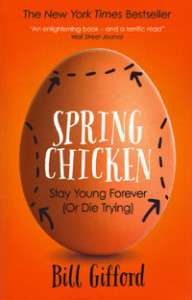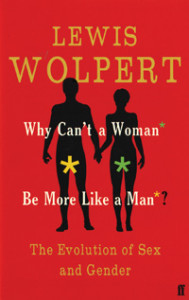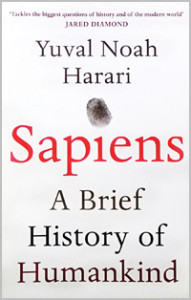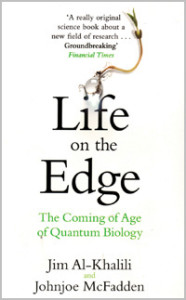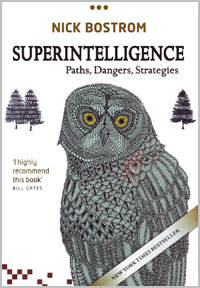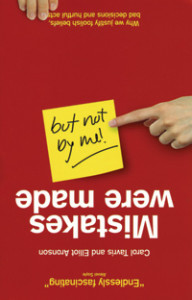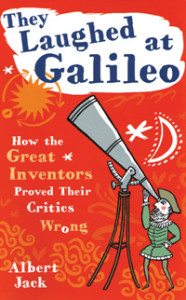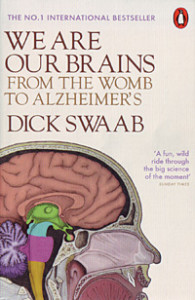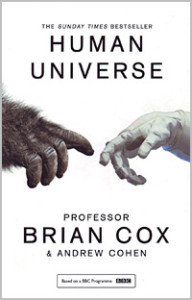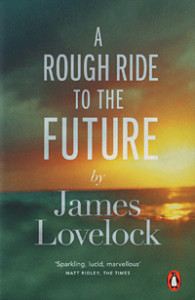Spring Chicken
Stay young forever (or die trying)
by Bill Gifford
Published by Oneworld www.oneworld-publications.com
“Time’s Winged Chariot poets say warns us to love while yet we may; Must we not hurry all the more who find it parked outside our door?”
Wynford Vaughan-Thomas
There’s a very brief appendix at the back of ‘Spring Chicken’ entitled ‘things that might work’. So if you want to ‘stay young forever’ as the book’s tag line suggests, what does work? Let me sum it up for you: nothing. Yet. Humans seem to have a built in ceiling of around 100 years give or take. However, if you want to reach that milestone still hale, hearty and compos mentis, Bill Gifford rounds up all the serious investigations into why we age, why we age differently and what we can do about it.
Most effective is careful choice of parents. Have the correct genetic inheritance and you can expect to see 100 on a diet of whisky, cigarettes and happy meals. If, for some unaccountable reason, this option is not available to you, there are various other – much less effective – courses of action. Unfortunately they mostly boil down to ‘eat less and exercise’ or, as Gifford puts it, “use it or loose it”. There are plenty of examples where this homily appears to hold true for both physical and mental capacity: Irving Khan working every day in his investment firm till his death at 109, 60 year olds missing the Olympic medal sprint time by 2 seconds and 90 year old pole vaulters. Clifford quotes several trials where even light mental and physical workouts produce measurable decreases in the biological markers of aging. It really does seem that it’s never too late to start too.
All of this is more ‘puddle of health’ than ‘fountain of youth’ but we do have some pieces of the puzzle even if none of them are corners. There are a bunch of genes and proteins we could do with more (or less) of. Caloric restriction definitely looks promising but liposuction and supplements on the other hand, seem to be counterproductive.
Beyond that, well, there are a lot of correlations here. If you have X your great grandkids will have to push you down the stairs for the inheritance. If you do Y you won’t make it to the end of the chapter. It’s not, however very clear which direction the causation runs in, or if it runs at all. Maybe all these centenarian metrics are a side effect of something else.
Resveratrol, telomeres, rapamycin, SIR2 – all have been touted in turn as the great white hope of anti-aging medicine. Gifford explores why, having generated a flurry of headlines, each has pretty much faded from view (though research continues with all of them). Blame the mice. Sure, you can get your mouse to live to the equivalent of 120 but humans have very different metabolic pathways and things that work wonders for a mouse often simply don’t work in a human body. GDF11 is the latest hope. A blood protein singled out as the rejuvenating element that reverses muscle and brain aging when blood circulation is mixed between old and young mice in a Frankensteiney operation called parabiosis. Unfortunately a recent (May 2015) paper in Nature seems to throw cold water on that research too.
I’ve been reading about how to evade ‘time’s winged chariot’ since Charles Panati’s ‘Breakthroughs’ in 1980 and I’m not one second younger for any of it. While ‘Spring Chicken’ does an excellent job of summarising the latest research I have a sneaking suspicion we’ve missed serious life-extension medicines by a generation or two (damn) but I hope I’m wrong. Reduce your senescence cells (cut out some desserts) and repair your mitochondrial DNA (brisk walks) and maybe you’ll last long enough to find out.
